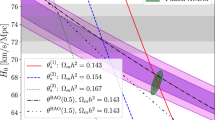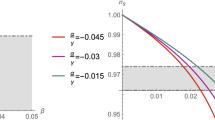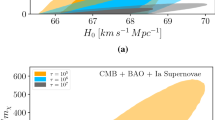Abstract
JACOBS1 has recently compared two types of cosmological models which change from a radiation-like model for early time to a matter-like model for recent time. The radiation in these models is in thermal equilibrium with the matter and the photons, neutrons and electrons are not treated separately (as they are, for example, in ref. 2). In a flat space (k = 0), the function R(t) of the line element  changes from being like At½ for early time to being like At2/3 for recent time. The two models Jacobs discusses will here be called model I and model II. R(t) is given in model I by
changes from being like At½ for early time to being like At2/3 for recent time. The two models Jacobs discusses will here be called model I and model II. R(t) is given in model I by  where
where  and in model II by
and in model II by  where β is a constant3. Here the density and pressure are
where β is a constant3. Here the density and pressure are  where ρr and ρm are the density of radiation and matter, respectively, pr is the pressure of radiation, the pressure of matter is put equal to zero, a is Stefan's constant and T is the radiation temperature. Also, for a Hubble parameter
where ρr and ρm are the density of radiation and matter, respectively, pr is the pressure of radiation, the pressure of matter is put equal to zero, a is Stefan's constant and T is the radiation temperature. Also, for a Hubble parameter  we define
we define  and
and  so that the conservation equation gives
so that the conservation equation gives  Em and Er were first defined by Davidson4 and are the total net rate of transfer of radiation energy per unit volume into matter energy and vice versa. A zero subscript denotes the present epoch. The present value of T is of the order of 3° K from the measurement of the isotropic microwave background first found by Penzias and Wilson5 and Roll and Wilkinson6. This is believed by many to be a remnant of the initial “big-bang” or “fireball”.
Em and Er were first defined by Davidson4 and are the total net rate of transfer of radiation energy per unit volume into matter energy and vice versa. A zero subscript denotes the present epoch. The present value of T is of the order of 3° K from the measurement of the isotropic microwave background first found by Penzias and Wilson5 and Roll and Wilkinson6. This is believed by many to be a remnant of the initial “big-bang” or “fireball”.
This is a preview of subscription content, access via your institution
Access options
Subscribe to this journal
Receive 51 print issues and online access
$199.00 per year
only $3.90 per issue
Buy this article
- Purchase on Springer Link
- Instant access to full article PDF
Prices may be subject to local taxes which are calculated during checkout
Similar content being viewed by others
Change history
01 January 1968
In the communication "Cosmological Models containing both Radiation and Matter" by C. B. G. Mclntosh (Nature, 216, 1297; 1967) equation (21) on 2 AB page 1298 should read t = ABc{e-3/2 (l-9e) + 6V3} (B = constant). Equation (24) should read pr,0 = 6.8 x 10-34 gm/cm3 and equation (25) should read xprc4 = 9H2c.
References
Jacobs, K. C., Nature, 215, 1156 (1967).
Wagoner, R. V., Fowler, W. A., and Hoyle, F., Astrophys. J., 148, 3 (1967).
McIntosh, C. B. G., Nature, 215, 36 (1967).
Davidson, W., Mon. Not. Roy. Astro. Soc., 124, 79 (1962).
Penzias, A. A., and Wilson, R. W., Astrophys. J., 142, 420 (1965).
Roll, P. G., and Wilkinson, D. T., Phys. Rev. Lett., 16, 405 (1966).
Chernin, A. D., Astro. Zhur., 42, 1124 (1965) [English translation in Soviet Astron.-A.J., 9, 871 (1966)].
Alpher, R. A., and Herman, R. C., Phys. Rev., 75, 1089 (1949).
Alpher, R. A., Gamow, G., and Herman, R. C., Proc. US Nat. Acad. Sci. (in the press).
McIntosh, C. B. G., Mon. Not. Roy. Astro. Soc. (in the press).
Mattig, Von W., Astronomische Nachr., 284, 109 (1958).
Partridge, R. B., and Peebles, P. J. E., Astrophys. J., 147, 868 (1967); ibid., 148, 377 (1967).
Davidson, W., and Narlikar, J. V., Rep. Prog. Phys., 29, 539 (1966).
Author information
Authors and Affiliations
Rights and permissions
About this article
Cite this article
MCINTOSH, C. Cosmological Models containing both Radiation and Matter. Nature 216, 1297–1298 (1967). https://doi.org/10.1038/2161297a0
Received:
Issue Date:
DOI: https://doi.org/10.1038/2161297a0
This article is cited by
-
Multi-fluid cosmology in Einstein gravity: analytical solutions
General Relativity and Gravitation (2021)
Comments
By submitting a comment you agree to abide by our Terms and Community Guidelines. If you find something abusive or that does not comply with our terms or guidelines please flag it as inappropriate.



